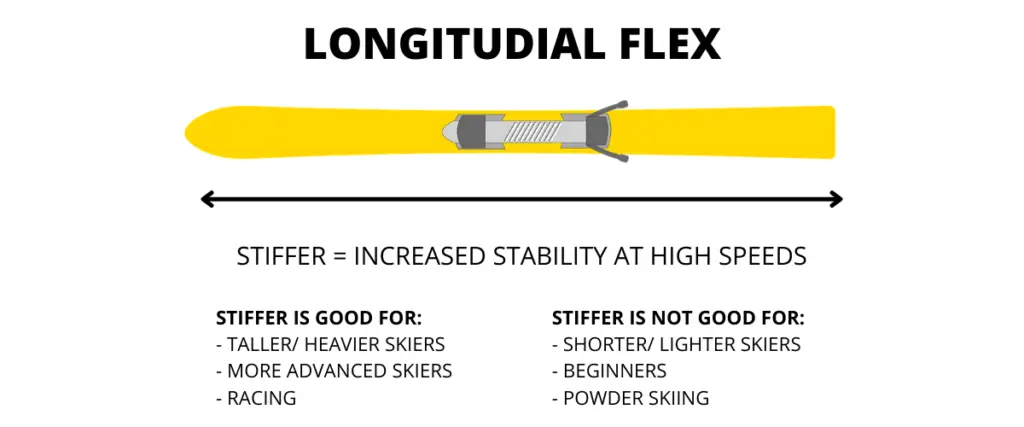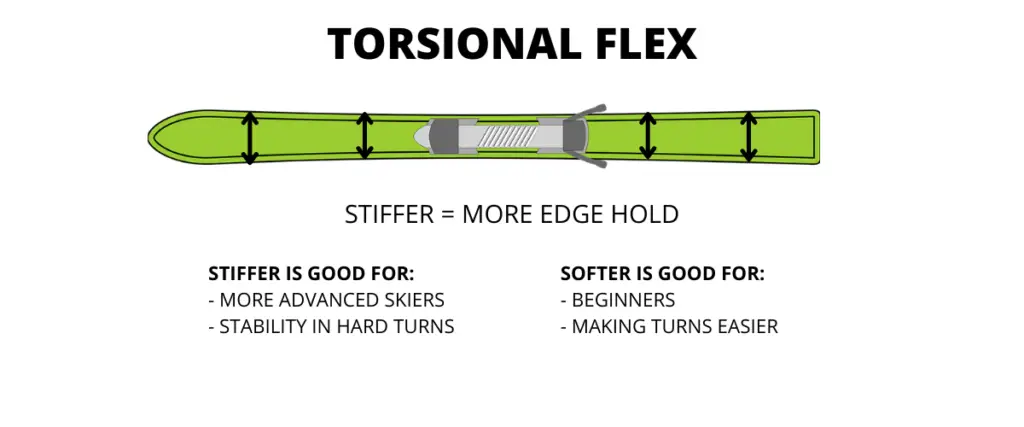The flexibility of a ski greatly impacts how it feels and performs. It’s very important that you choose a pair of skis which have the right level of stiffness for your physique, style and ability level.
I’ll be explaining the difference between soft and stiff skis and their pros and cons so you can decide which pair of skis are the best for you.
Ski Stiffness 101
Softer skis with more flexibility are better suited to shorter and lighter skiers. Stiffer skis are better for taller and heavier skiers and more aggressive styles. Soft skis feel more forgiving and are better for beginners whereas stiffer skis feel more stable at high speeds and are more responsive.
There are two types of flex to consider when determining the overall stiffness of a ski:
- Longitudinal flex
- Torsional flex
The flex pattern of a ski refers to both its longitudinal and torsional stiffness.

Longitudinal Flex
Longitudinal flex refers to the flexibility of the ski lengthways (from the tip to the tail). The flex rating given by the manufacturer generally refers to how soft or stiff the longitudinal flex is. It is affected by the length and materials used to make the core and structural layers.
Longitudinal flex affects:
- Speed
- Stability
- Responsiveness
Less longitudinal flex = stiffer = more stable, faster and responsive
Hence, having less longitudinal flex is preferred by more advanced skiers whereas beginners will usually prefer a ski with more longitudinal flex as it feels more forgiving and easier to learn on. The added stability provided by a stiffer ski is not needed for the lower speeds beginners are travelling at.

Torsional Flex
Torsional flex refers to the flexibility of the ski widthways (from one edge to the other). The torsional flex is typically not graded by manufacturers but it is still important to consider. Torsional flex is determined by the composition and layout of the ski’s structural layers.
The amount of torsional flex a ski has affects how easy it is to turn and carve.
Less torsional flex = stiffer = more edge hold
A ski with more torsional flex makes turning easier and is often preferred by beginners. A ski with less torsional flex will feel stiffer and provides more grip making it feel more powerful. Hence, more advanced skiers often prefer stiffer torsional flex.

Ski Flex Ratings
Most manufacturers will rate their skis on a scale of 1-10 with 1 being the most flexible and 10 being the stiffest.
| Ski Flex Rating | Description |
| 1-2 | Soft |
| 2-3 | Soft-Moderate |
| 5-6 | Moderate |
| 7-8 | Moderate-Stiff |
| 9-10 | Stiff |
You can use the flex rating when trying to narrow down your selection of available skis.
However, keep in mind that there is no universal flex rating for skis. The scale for every manufacture will be slightly different.
For example, a pair of skis by Salomon and Volkl are unlikely to have the same flexibility even if they have the same flex rating.

Soft vs Stiff Skis
The appropriate stiffness of your skis will depend on your:
- Height
- Weight
- Skill-level
- Preferred terrain/ type of skiing
A softer (more flexible) ski is recommended for shorter and lighter skiers as stiffer skis will be more difficult to control. Taller and heavier skiers are better suited to stiffer skis as they will provide more stability and support.
Beginners are usually best off with a more flexible ski as they are more forgiving and comfortable to learn on. More advanced skiers will typically select a stiffer pair of skis because they feel grippier, faster, more stable and more responsive. Stiffer skis are harder to control but this is not an issue for those with more experience.
The type of skiing you’re doing will also affect the suitable ski stiffness.
- Powder: softer skis are better for powder skiing.
- All-mountain: medium-flex skis typically work best for all-mountain skiing as they are the most versatile.
- Racing: stiff skis are recommended for racing as they are more stable at higher speeds.
What Affects the Stiffness of a Pair of Skis?
The flexibility of a ski is affected by the width, length, and materials it is constructed from. Carbon and fiberglass skis are typically stiffer compared to plastic skis. Skis which have a wooden core are also stiffer than skis which have a foam core.
Check out this article to learn more about foam vs wood core skis.

